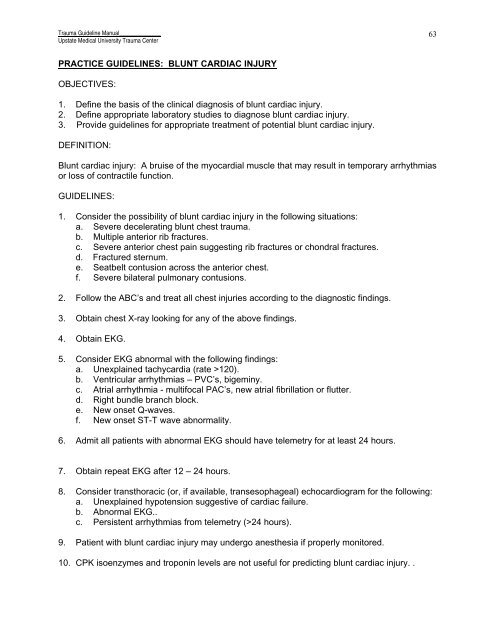Trauma Guideline Manual - SUNY Upstate Medical University
Trauma Guideline Manual - SUNY Upstate Medical University
Trauma Guideline Manual - SUNY Upstate Medical University
Create successful ePaper yourself
Turn your PDF publications into a flip-book with our unique Google optimized e-Paper software.
<strong>Trauma</strong> <strong>Guideline</strong> <strong>Manual</strong>______________<strong>Upstate</strong> <strong>Medical</strong> <strong>University</strong> <strong>Trauma</strong> Center63PRACTICE GUIDELINES: BLUNT CARDIAC INJURYOBJECTIVES:1. Define the basis of the clinical diagnosis of blunt cardiac injury.2. Define appropriate laboratory studies to diagnose blunt cardiac injury.3. Provide guidelines for appropriate treatment of potential blunt cardiac injury.DEFINITION:Blunt cardiac injury: A bruise of the myocardial muscle that may result in temporary arrhythmiasor loss of contractile function.GUIDELINES:1. Consider the possibility of blunt cardiac injury in the following situations:a. Severe decelerating blunt chest trauma.b. Multiple anterior rib fractures.c. Severe anterior chest pain suggesting rib fractures or chondral fractures.d. Fractured sternum.e. Seatbelt contusion across the anterior chest.f. Severe bilateral pulmonary contusions.2. Follow the ABC’s and treat all chest injuries according to the diagnostic findings.3. Obtain chest X-ray looking for any of the above findings.4. Obtain EKG.5. Consider EKG abnormal with the following findings:a. Unexplained tachycardia (rate >120).b. Ventricular arrhythmias – PVC’s, bigeminy.c. Atrial arrhythmia - multifocal PAC’s, new atrial fibrillation or flutter.d. Right bundle branch block.e. New onset Q-waves.f. New onset ST-T wave abnormality.6. Admit all patients with abnormal EKG should have telemetry for at least 24 hours.7. Obtain repeat EKG after 12 – 24 hours.8. Consider transthoracic (or, if available, transesophageal) echocardiogram for the following:a. Unexplained hypotension suggestive of cardiac failure.b. Abnormal EKG..c. Persistent arrhythmias from telemetry (>24 hours).9. Patient with blunt cardiac injury may undergo anesthesia if properly monitored.10. CPK isoenzymes and troponin levels are not useful for predicting blunt cardiac injury. .
















